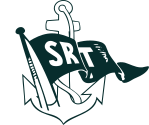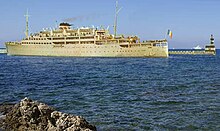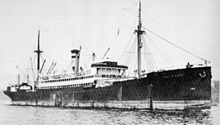Sovromtransport
| Sovromtransport
|
|
|---|---|
| legal form | Soviet-Romanian joint venture |
| founding | July 14, 1945 |
| resolution | September / October 1954 |
| Reason for dissolution | Transfer to the state-owned Romanian shipping company Navrom |
| Seat | Bucharest , Romania |
| Branch | shipping |
The Sovromtransport (SRT), actually "Societatea de Navigație Sovieto-Română", was a Soviet - Romanian shipping company that existed from 1945 to 1954.
Foundation, tasks and equipment
After the end of the Second World War , the Soviet and Romanian governments founded a number of joint companies in agriculture , mining , industry and transport - the " Sovroms ". A total of 16 of these joint ventures were set up, including Sovrompetrol , Tars ( Transporturi Aeriene Româno-Sovietice ), Sovrombanc and Sovromtractor . Its purpose was given to rebuild the economy and, indirectly, to monitor Romanian debt payments to the Soviet Union. In reality, they served the Soviet Union to use the Romanian resources for its own interests.
As one of the first Sovrom companies, Romania and the Soviet Union founded the Sovromtransport shipping company on July 19, 1945 . The shipping company's task was to transport people and freight on the Danube and the Black Sea . As a joint venture, both sides should each hold 50 percent of the shares, but in reality this shifted: Sovromtransport was 51.2% owned by the USSR and 49.8% owned by Romania.
As initial equipment, the Romanian side brought in the two ships returned from the Soviet Union, the Transilvania and the Ardeal, as well as numerous inland vessels on the Danube. The previous owners of the ships, the two state-owned shipping companies Serviciul Maritim Român (SMR) for seagoing vessels and Navigaţia Fluvială Română (NFR) for inland waterways, were taken over into the new company and thus Sovromtransport was the legal successor. In addition, the Romanian government agreed to grant Sovromtransport all rights to use the ports and the shipyards in Constanța , Galatz , Brăila and Giurgiu . The Soviet Union brought in the four older cargo ships Dimitrov , Berezina , Plechanow and Friedrich Engels .
The company was headquartered in Bucharest , and the shipping company set up regional offices in Constanța, Galatz, Braila, Giurgiu and Turnu-Severin , and each of these regional offices had subordinate agencies. At the end of 1948, the Sovromtransport fleet consisted of seven sea- going vessels with approx. 27,000 GRT as well as around 400 inland vessels with tugs , barges , tankers , cargo ships and passenger ships .
In the following years, Sovromtransport took over all other inland shipping companies and also expanded the fleet of their seagoing ships: Private shipping companies such as the Societatea Anonimă Română de Navigațiune pe Dunăre (SRD) were nationalized and integrated by 1949. This made it the only shipping company in Romania. Romania added four newbuildings to its fleet of seagoing vessels in 1950: the Constanta and Mangalia were originally German ships completed in Hungary , and two other ships, Midia and Sulina , came from Romanian shipyards.
Served routes
Details of the routes operated by Sovromtransport are not available, and there are also no figures for freight or passenger traffic. In inland waterway transport, the traffic of goods and passengers between the Romanian sea and inland ports as well as cross-border traffic is relevant, but cannot be quantified.
The emigration of Romanian Jews to Israel with Romanian ships is the most well-known aspect of the traffic on sea ships . At the beginning of the Second World War, Romanian ships were carrying Jewish emigrants to Haifa . This emigration was continued after the war, for which the passenger ship Transilvania was used as the only ship of the Sovromtransport . After the end of the emigration movement in 1952, the ship was used as a cruise ship in the Black Sea, and later also in the Mediterranean . From the end of November 1945, the Transylvania also began regular service on the route between Constanța and Marseille. It remains to be clarified whether or to what extent the cargo ships were only used in the Black Sea or further to the Mediterranean or beyond.
Dissolution of the shipping company
After the death of Josef Stalin, the Romanian government took advantage of the beginning thaw period in the Soviet Union and dissolved the Sovrom companies. In September or October 1954 she liquidated the Sovromtransport and transferred to the shipping company in the newly founded in February 1955 state shipping company Navrom .
Sea merchant ships of Sovromtransport
| Surname | tonnage | Construction year | in the service of the shipping company | Notes, whereabouts |
|---|---|---|---|---|
| Transylvania | 6672 BRT, 3091 NRT | 1938 | 1845-1955 | 1938 to Serviciul Maritim Român , interned in Istanbul in 1941, 1945 to Sovromtransport , 1955 to Navrom , 1975 out of service, capsized and scrapped in 1979. |
| Ardeal | 5695 BRT 3426 NRT |
1922 | 1948-1954 | Formerly German freighter Emil Kirdorf , sold to Romania in 1932, Soviet booty in 1945, returned in 1948, to Navrom in 1955 , scrapped in 1962. |
| Dimitrov | 3688 BRT, 2291 NRT | 1919 | 1948-1954 | 1919 as Haarlem to Koninklijke Nederlandsche Stoomboot Maatschappij , 1934 as Dimitrov to Chernomorskoye Gosudarstvyennoye Morskoye Parokhodstvo , Odessa , 1948 to Sovromtransport , 1954 to Navrom , 1962 renamed Oltenia , out of service in 1971 and broken up until 1972. |
| Berezina | 3125 BRT, 1885 NRT |
1918 | 1950-1954 | 1918 British War Highway , 1919 Seatonia , 1927 Bracondale , 1934 sold to Sovtorgflot , Leningrad, as Berezina , 1950 to Sovromtransport , 1954 to Navrom , renamed Eforie in 1962 , unclear whether it was scrapped in 1978, allegedly still seen in Braila in 1999. |
| Plekhanov | 3742 BRT, 2109 NRT |
1900 | 1949-1954 | 1900 as Aristea to Italy, 1915 as Kako to the Imperial Russian Navy , 1922 registered in Petrograd, 1934 renaming to Plekhanov , 1948/49 to Sovromtransport , 1954 to Navrom , broken up in 1964. |
| Friedrich Engels | 3969 GRT | 1930 | 1946-1954 | Built in Leningrad in 1930 , in Arctic convoys during World War II, sold to Sovromtransport in 1946 , renamed Mamaia in 1962 when moving to Navrom , in service until the 1980s. |
| Mangalia | 659 GRT, 384 NRT |
1950 | 1950-1954 | Originally a German design for the Black Sea standard ship , completed in Hungary in 1950 and sent to Sovromtransport , 1954 to Navrom , 1970 to the Marine Research Institute in Constanta, whereabouts unclear. |
| Constanța | 659 GRT, 384 NRT |
1950 | 1950-1954 | Originally a German design for the Black Sea standard ship , completed in Hungary in 1950 and sent to Sovromtransport , 1954 to Navrom , 1963 renamed Tulcea , whereabouts unclear. |
| Midia | approx. 600 GRT | 1950 | 1950-1954 | Details about the ship are not available. |
| Sulina | approx. 600 GRT | 1950 | 1950-1954 | Details about the ship are not available. |
literature
- Carmen Irène Atanasiu: Flota comercială română sub control sovietic - Sovromtransport [The Romanian merchant fleet under Soviet control - Sovromtransport ] (Romanian), (original place and year of publication unknown), online version at romaniaforum.info
- Csaba Bekes, Laszlo Borhi, Peter Ruggenthaler, Ottmar Trasca (Eds.): Soviet Occupation of Romania, Hungary, and Austria 1944 / 45–1948 / 49 , Central European University Press, Budapest - New York 2015, ISBN 978-963-386 -099-1 ( limited online view of Google Book Search )
- SH Steinberg: The Stateman's Year-Book: Statistical and Historical Annual of the States of the world fort he year 1957 , Macmillan & Co. Ltd. / St. Martins's Press, London / New York 1957, ( limited online view of Google book search ).
- Marian Mosneagu: Politica navala postbelica a Romaniei (1944-1958). Editura "Mica Valahie", 2011, ISBN 978-606-8304-14-4 .
- Valentin Ciorbea: Flota maritima comerciala romana: Un secol de istorie moderna 1895–1995 , Editura Fundației "Andrei Șaguna", Constanța 1995, ISBN 973-97270-0-X .
- Radu Ioanid: Securitatea și vânzarea evreilor. Istoria acordurilor secrete dintre România și Israel [Security and Sale of Jews. History of the secret agreements between Romania and Israel] , Editura Polirom, Bucharest 2015, ISBN 978-973-46-5072-9 , ( limited online view of Google Book Search ).
Web links
- “Sovromtransport”, in: Enciclopedia României , accessed on October 2, 2018
- Dan-Eugen Sambra: "Transilvania" și "Basarabia", "lebedele Mediteranei" (1938–1979) at altmarius.ning.com, accessed on November 14, 2018
Footnotes
- ↑ a b c d e f g Atanasiu
- ↑ a b Bekes, p. 139
- ↑ Klaus Becker: Die Binnenschiffahrt Südosteuropas nach 1945 , In: Der Donauraum, Volume 15, Research Institute for Issues of the Danube Region, Böhlau 1970, p. 39
- ↑ Mosneagu, p 391
- ↑ Steinberg, p. 1352
- ↑ Franz Pichler: The Danube Commission and the Danube countries: cooperation and integration, Braumüller, 1973, p 19
- ↑ CIA report on Sovromtransport from April 11, 1947
- ↑ CIA report on Sovromtransport of 26 February 1953: Personnel and ships
- ↑ a b Enciclopedia României
- ↑ Nave de istorie - Nava Transilvania
- ↑ cf. Ioanid
- ↑ Sambra
- ↑ Reinhart Schmelzkopf, Neculai Padurariu: The sea merchant ships of Romania 1878-1944 (Part II) , In: Strandgut 61 , 2006, p. 148
- ^ Reinhart Schmelzkopf: Stranger Ships in German Hands , Strandgut Verlag, Cuxhaven 2004, p. 21
- ^ Arnold Kludas : The history of the German passenger shipping. Volume IV: Annihilation and rebirth 1914 to 1930 , Weltbild Verlag, Augsburg 1994, p. 178
- ↑ Reinhart Schmelzkopf: Die deutsche Handelsschiffahrt 1919–1939. Volume 2: List of all ships over 500 GRT with all technical and historical data. Verlag Gerhard Stalling, Oldenburg / Hamburg 1975, ISBN 3-7979-1859-3 , p. 106
- ^ Name ship: Haarlem at Maritiem-Historische Databank
- ^ War Highway , at Sunderland Built Ships
- ↑ 1918 - 2005: Eforie , at romaniaforum.info
- ↑ 1900–1964: Plehanov , at romaniaforum.info
- ↑ Mamaia at balticshipping.com
- ^ Roy Fenton: Tramp Ships. An Illustrated History , Seaforth Publishing, Barnsley 2013, ISBN 978-1-84832-158-8 , p. 98 ( limited online view of the Google book search )
- ↑ NH 89915 SS FRIEDRICH ENGELS (USSR Merchant Cargo Ship, 1931-) , at history.navy.mil
- ↑ CIA report on Sovromtransport from September 11, 1951


